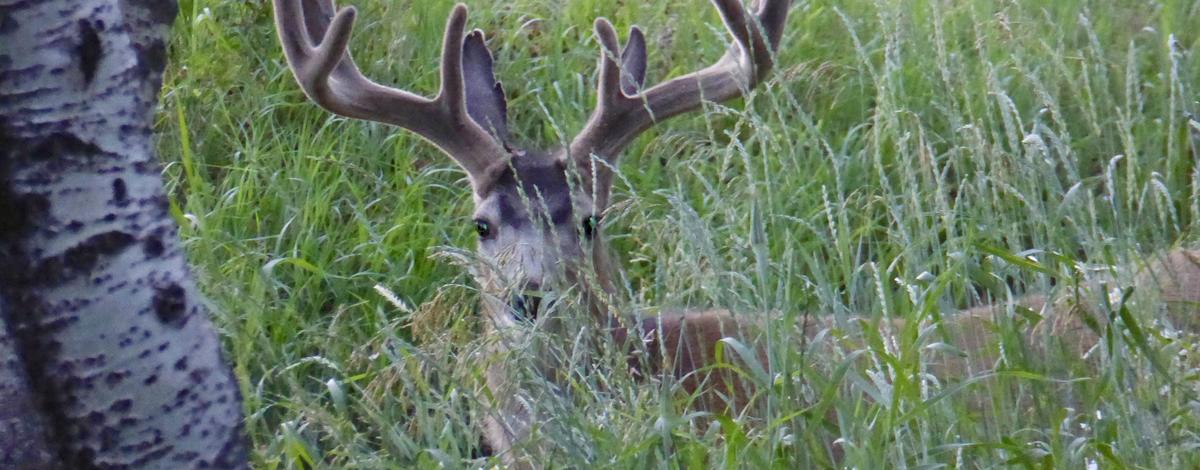Deer and elk hunters should see plenty of game in Idaho during fall hunts as mild winters have helped rebound mule deer herds hit hard in recent years, and Idaho's elk herds continue to soar and harvests have come roaring back over the last six years.
Mule deer
In recent years, mule deer hunting has been on a bit of downswing, but 2020 could shape up to be a momentum changer.
The three-year stretch of winters spanning from 2016-2019 was tough on many of Idaho’s mule deer herds, largely due to poor-to-average fawn survival — including the second-lowest on record in 2016-17 — and harvest numbers have reflected that trend.
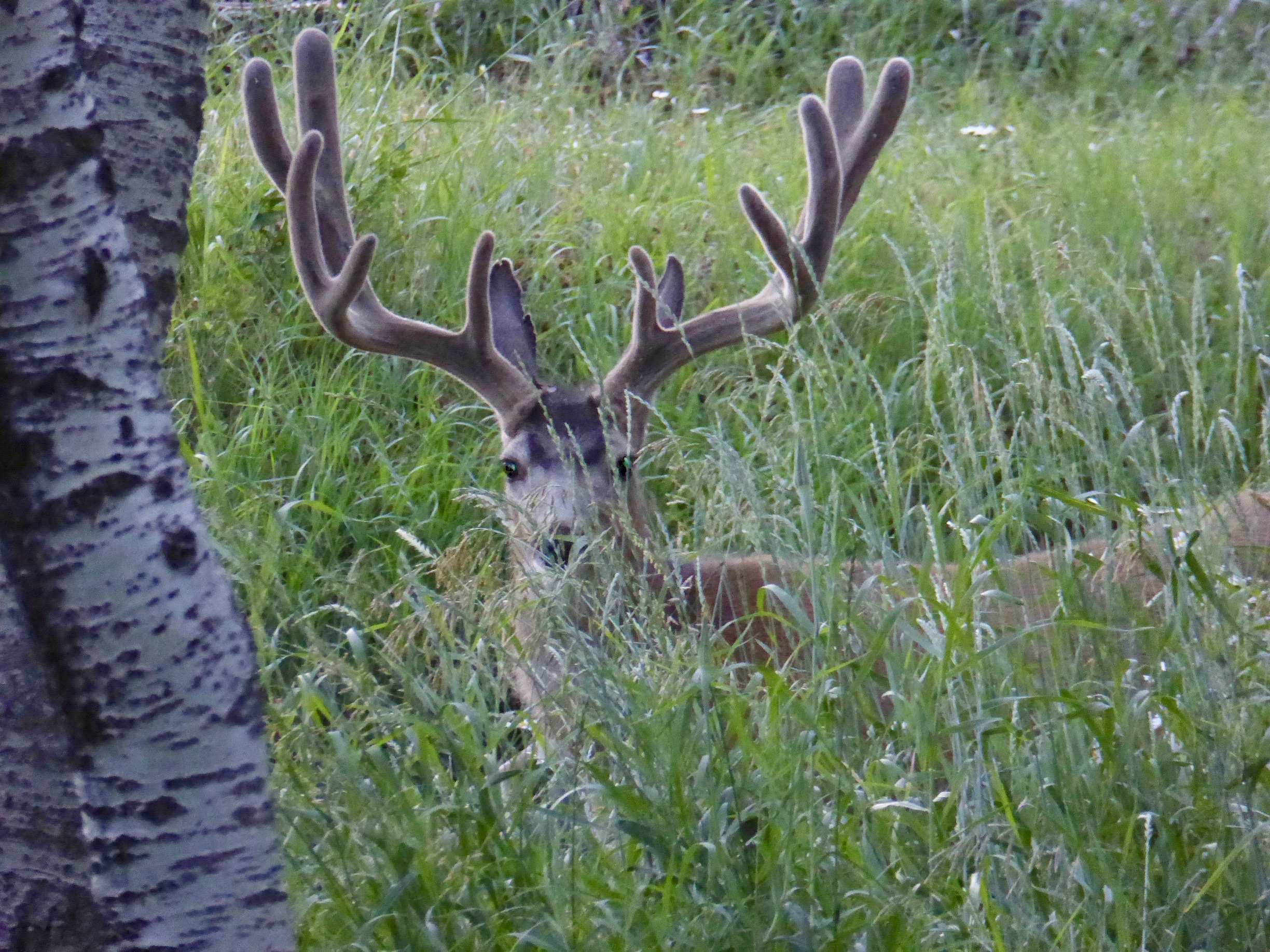
In 2019, Idaho hunters harvested 23,679 mule deer, 3,294 fewer than 2018, which is a decrease of about 12 percent. It was the lowest total since 2011, and about 15 percent lower than the 10-year average harvest of 27,964 animals. When you consider that about 80 percent of the mule deer in Idaho’s herds are between 1 and 3 years old, and take a look at the winter fawn survival numbers for the few years leading up to 2019, the dip in harvest was likely inevitable.
The good news for Idaho mule deer hunters is that the statewide fawn survival data from last winter paints a brighter picture for 2020.
“Harsh winters tend to have more of an effect on mule deer than they do on elk. The flip side of that is when conditions are good, a deer herd can grow more rapidly than an elk herd,“ said Rick Ward, Deer/Elk Program Coordinator. “Throughout southern Idaho this winter, we had above average winter fawn survival, which bodes well for the upcoming mule deer season.”
About 63 percent of radio collared fawns survived last winter, which is the highest number in four years and above the 20-year average of 57 percent. Couple that with the fact that, despite poor-to-average fawn survival from 2016-19, overwinter survival of does remained high (above 90 percent), and Fish and Game reduced antlerless hunting opportunities to further protect breeding-age does and prime the state’s mule deer herds for a rebound.
The indications are there will likely be more young bucks available for hunters to pursue this fall. In the grand scheme of 2020 hunting season, that could be significant, because yearling, or two-point bucks (which were born last year), typically make up a significant portion of the buck harvest. All things considered, it will likely to be a good year for mule deer hunters — although they shouldn’t expect any harvest records to be broken in 2020.
“While it was above average, the overwinter survival of this year’s crop of fawns is not going to make up for the poor survival we saw in 2016-17 and 2018-19 in one fell swoop, particularly in those areas that were hit hardest in those years,” Ward said. “But it is a positive sign for our mule deer herds and for hunters.”
It should be noted that fawn survival was not consistent throughout the state, so some areas were closer to average, and a few fell below. The number of animals available for hunters, as well as success rates, will vary significantly throughout mule deer country.
While many of the mule deer herds around the state are in better shape this year than they were in 2019, Ward pointed out that hunter congestion could prove to be more prevalent this year, particularly in areas that are more popular with mule deer hunters.
Because resident general deer tags are sold throughout the hunting season and unlimited for residents, it’s hard to project how many of resident hunters will be in the field come fall. However, if the the speed at which nonresident general deer tags sold out this year (two months sooner than they did in 2019) is any indication, deer hunter numbers could also be up this year after dropping a bit from 2018 to 2019.
2019 harvest at a glance
- Total mule deer harvest: 23,679
- Overall hunter success rate: 29 percent
- Antlered: 18,633
- Antlerless: 5,046
- Taken during general hunts: 17,697 (25 percent success rate)
- Taken during controlled hunts: 5,893 (49 percent success rate)
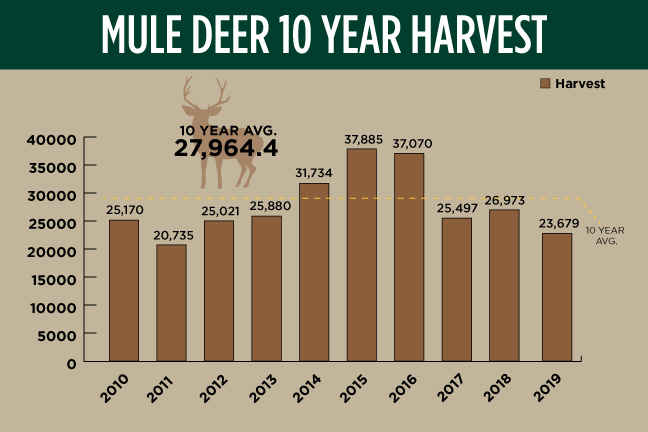
Elk
Idaho elk hunters enjoyed another year of excellent hunting in 2019, harvesting 20,532 animals statewide. Elk hunters in 2020 can expect that trend to continue.
“I think all indications are that this should be another very good elk season,” Ward said.
Fish and Game is currently meeting or exceeding its population goals for bull elk in 17 of 22 elk zones, and 16 out of 22 for cow elk, Ward said. The elk harvest in 2019 was down from the prior year by about 8 percent, but it was still good for fourteenth highest of all time, and fifth highest in the past decade. The statewide elk harvest has exceeded 20,000 annually for the last six years, which has not happened since the all-time high harvests between 1988-96.
“We are in the second Golden Age of Idaho elk hunting,” Ward said. “The distribution of elk has definitely changed since the 80s and 90s, when there was that first pulse of high elk numbers and the Lolo Zone was leading the the way. That’s not the case anymore, but now our elk populations in the front country — particularly in Southern Idaho — are doing fantastic.”
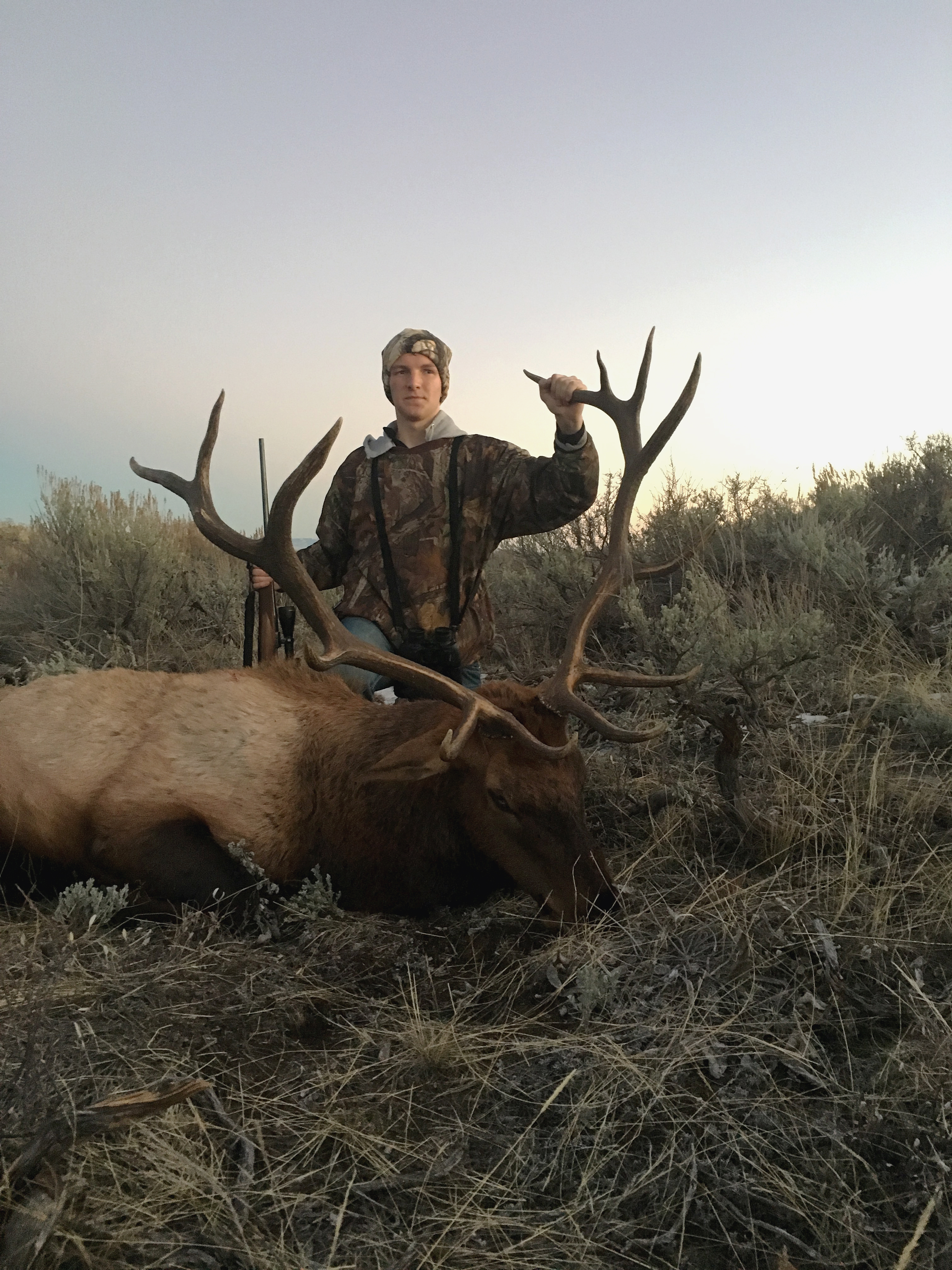
As word has gotten out about the resurgence of elk hunting in Idaho, there has been a corresponding increase in the number of hunters, which have exceeded 100,000 annually over the last six years. Fish and Game’s generous allocation of over-the-counter, general hunt tags, and a broad range of antlered hunting opportunity, particularly for archery hunters, is appealing to resident and nonresident hunters. The allotment of nonresident elk tags sold out by June 17 this year. It's the fourth-straight year that has occurred, and it’s happened earlier each year.
During 2019-20 winter, Fish and Game managers monitored 704 radio collared elk in various parts of the state. Adult cow survival was 97 percent and calf survival was 73 percent — up from 66 percent in the 2018-19 winter. The leading cause of mortality for elk calves was mountain lions, and for cow elk it was a tie between hunter harvest and mountain lions.
Ward said that elk tend to be hardier than mule deer and capable of withstanding harsh winters. That typically makes elk populations easier for biologists to manage through hunting. As elk populations have redistributed and continue to grow in these "front country" areas, in some cases pushing the boundaries of social tolerance, it has presented wildlife managers with unique challenges. During the last season setting cycle in 2019, wildlife managers responded by offering increased elk hunting opportunity in these areas, including general, either-sex hunts; over-the-counter cow tags; and generous antlerless controlled hunt tags. These expanded antlerless opportunities are a great way for hunters to put meat in the freezer while helping to manage elk populations, and it’s something they should take greater advantage of this year.
“One of the challenges we face in managing elk populations is getting enough hunters to hunt hard for and harvest antlerless elk in areas where we are working to bring elk herds back to the population objectives in the statewide elk plan,” Ward said.
2019 harvest at a glance
- Total elk harvest: 20,532
- Overall hunter success rate: 22 percent
- Antlered: 11,418
- Antlerless: 9,114
- Taken during general hunts: 13,799 (18 percent success rate)
- Taken during controlled hunts: 6,733 (38 percent success rate)
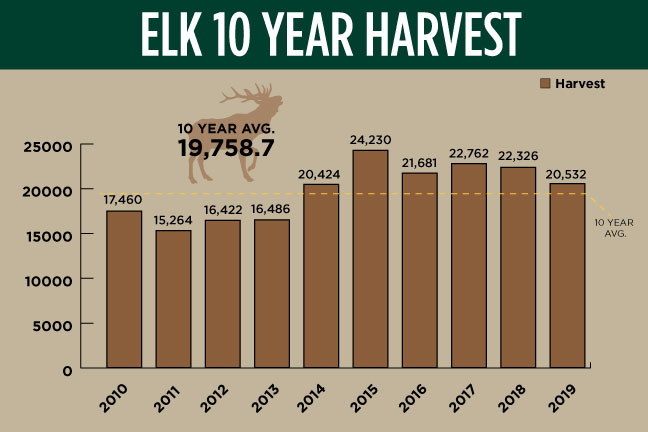
White-tailed deer
There’s a bit of irony when it comes to Idaho’s whitetail hunting. It’s been so good for so long that good has become average.
When you look back since 2004 when Idaho’s deer harvest statistics were segregated between whitetails and mule deer, whitetails were a smaller portion of the statewide deer harvest with mule deer being the majority of deer taken by hunters.
But over the years, that proportion has shifted and whitetails now represent nearly half of the statewide deer harvest, despite 90 percent of whitetail harvest coming out of just two regions: the Panhandle and Clearwater.
There are two main reasons for whitetails' ascent. First, Idaho’s whitetails are abundant and resilient, which means there’s a steady population of animals available to hunt. Second, Fish and Game offers long seasons, generous either-sex hunting opportunities, and unlimited general season tags for residents.

Hunters took 21,540 whitetails in 2019 and had a 38 percent success rate. Whitetail harvest was still below mule deer (23,679), but whitetail hunters’ success rates were nine points higher than mule deer hunters.
While 2019 whitetail harvest was down 14 percent from 2018 and the lowest since 2011, biologists said that’s likely a normal variation in annual harvests, not a sign of declining whitetail populations. They point out that weather during hunting season can account for a 10 to 20 percent swing in harvest, and there’s been no unusually harsh winters in the Panhandle and Clearwater regions that might have curbed the state's largest whitetail populations.
However, biologists are trying to learn more about Idaho’s whitetail populations and what drives them, as well as what might limit them. They’ve started a multi-year study so they can learn more about whitetail populations and become better at managing them to ensure healthy populations and meet hunters’ expectations.
Whitetail hunters should expect good, or average, whitetail hunting in the state again in 2020. Winter weather was normal and there were no signs of excessive winter die off. So far, there’s no sign of an EHD or blue tongue outbreak, which are two diseases that can hit in late summer and kill lots of whitetails right before hunting season.
With a little help from the weather and plenty of hunters in the woods, there’s no reason the 2020 whitetails harvest can’t bounce right back to around the 10-year average of 24,568 white-tailed deer.
2019 harvest a glance
- Total white-tailed deer: 21,540
- Overall hunter success rate: 38 percent
- Antlered: 13,965
- Antlerless: 7,576
- Taken during general hunts: 19,485 (37 percent success rate)
- Taken during controlled hunts: 2,055 (45 percent success rate)
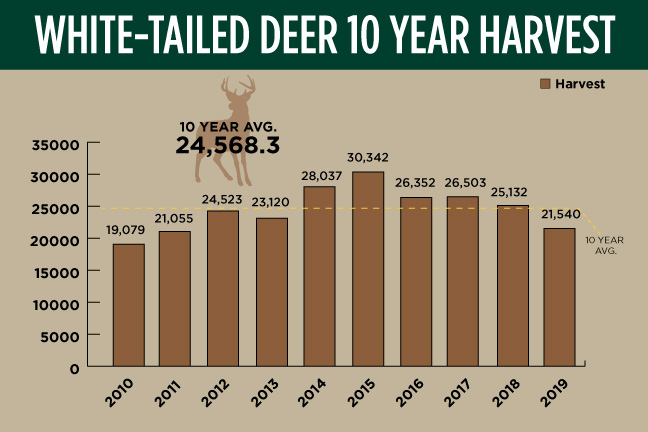
More hunting information
Hunt details by game unit, harvest statistics, detailed maps of each unit, and hunt areas showing ownership and access can be found using Fish and Game's Hunt Planner, or hunters can also contact regional Idaho Fish and Game offices.
Here are regional outlooks compiled by regional wildlife managers and biologists in each Fish and Game region
Panhandle Region
Deer: Whitetail hunters should be see the usual healthy herds of whitetails in Panhandle. Fawn production and winter survival have been good the last two years, and the region has not had population setbacks in the recent years. Unit 1, which encompasses the northern part of the state, was the top whitetail producer in 2019, and remains a perennial top deer producer that shows no signs of letting up. But it's not alone as a top producer in the Panhandle. Units 2, 3, 5 and 6 were also in the top 10 for whitetails thanks to habitat and weather conditions that have been favorable for growing whitetails. Whitetail hunters in the Panhandle have a long hunting season, generous either-sex hunting opportunities and a good chance to encounter mature bucks.
Elk: Elk numbers in the Panhandle also remain strong with Units 1 and 4 being among the top elk units in the state, ranking fourth and third in 2019, and Panhandle units accounted for half of the top 10 elk units in the state with the Units 3, 6 and 5 joining Units 1 and 4.
With elk survival and production both ranging from moderate to high, hunters will have plenty of elk to pursue in the Panhandle Region in 2020 and should have a good-to-excellent hunting there.
What hunters should be aware of for the fall: Hunters in the Panhandle are reminded that more than 336,000 acres of private timberland is open to hunting due to Fish and Game’s Large Tracts access program, which pays private landowners to provide public access for hunting, fishing, trapping and other outdoor recreation.
-Micah Ellstrom, Panhandle Regional Wildlife Manager
Clearwater Region
Deer: Herds appear in good shape due to a mild winter with mixed snow depths and much of it coming later in winter. Deer survival was good with no sign of excessive winter kill and no signs of fatal disease outbreaks, such as EHD or blue tongue, occurring so far during summer.
Based on that, hunters can expect to find plenty of white-tailed deer in the Clearwater Region and hunting very similar to recent years. Units 10A and 8A were the second and third top whitetail producers last year, and are frequently in the top five for the state in recent years. With several mild-to-moderate winters in the Clearwater in recent years, hunters should see a fair-to-good number of mature bucks.
Elk: Elk herds are stable in most of the region, and hunters will also see similar hunting to recent years, but there’s some signs of growing herds in the Selway and Lolo elk zones, but modest growth.
Biologists continue to monitor cow and calf elk via radio collars to see how well the animals are surviving, or what’s killing them. They’re trying to figure out what’s happening with the herds and what’s driving, or limiting, the elk populations.
The Palouse, Dworshak and Hells Canyon elk zones continue to produce good elk hunting in the region, and the Elk City Zone is seeing increased harvest in unit 14, but decreases in units 15 and 16, which is attracting more hunters into Unit 14.
Biologists have seen an increase in large wildfires in portions of the Clearwater, which historically has benefited elk herds, so they’re hopeful they could see improved forage for elk and a corresponding increase in elk herds.
What hunters should be aware of for the fall: Hunters in the Clearwater are reminded that 567,000 acres of Potlatch Deltic timberlands are open to the public due to Fish and Game’s Large Tracts access program, which pays private landowners to provide public access for hunting, fishing, trapping and other outdoor recreation. Hunters should also note Potlatch Deltic requires special permits for camping and ATV use on its lands.
Clay Hickey, Clearwater Regional Wildlife Manager
Southwest Region – McCall
Elk: Lots of elk in the Weiser River Zone continues to be a good problem to have, but still a problem. Despite general hunts that include antlerless elk with any weapon, the zone is still over its objectives for elk. Too many elk? Isn’t that a good thing? Not exactly because some of those elk still cause damage to agriculture operations, so Fish and Game is offering generous antlerless hunting opportunities.
Weiser River and Brownlee zones (Brownlee is limited to controlled hunts) remain over objectives for elk, and Brownlee Zone has a bull/cow ration that is “out of this world."
Despite lots of elk, they can often find refuge on private lands, or on steep, rugged public land that is difficult to access. So while the elk are there, that doesn’t mean they’re easy to hunt.
The McCall Zone also has lots of elk and lots of public lands to pursue them, but road access is limited in much of the zone and hunters have to pursue them in steep, brushy backcountry that may put them to the test.
Deer: The Weiser/McCall area has had two hard winters in the last 5 years, which set back mule deer herds. Biologists saw excellent fawn survival last winter, which will boost the number of young bucks available for hunters, but overall deer populations are still down.
Biologists surveyed the area in 2010 and again last winter and saw about 30 percent fewer deer. While there should be more young bucks this year, there will still be limited numbers of older bucks because the harsh winter of 2016-17 essentially wiped out the 2016 fawn crop, which would now be mature bucks had they survived. Because deer numbers remain down, antlerless hunting opportunities are limited to youth hunters, and only during the first week of the general any-weapon season.
Mule deer account for most of the deer in the area, but about 40 percent of the deer in Unit 23 are whitetails, and whitetail herds remain stable in that unit.
-Regan Berkley, McCall Regional Wildlife Manager
Southwest Region – Nampa
Elk: The Boise River Zone has seen consistently high winter calf and cow survival rates during the past six years. The population has remained stable due to antlerless harvest opportunity, and this year had good winter calf survival again.
The elk harvest in the Boise River Zone has also remained largely stable over that time period (averaging about 956 animals), as has the hunter success rate. The 2019 elk harvest came in at 945 animals, with a 19 percent success rate. The Boise River Zone is composed of just a single hunting unit (Unit 39), which has been the top unit for elk harvest for two straight years and routinely competes with Unit 1 in Northern Idaho for the top spot.
Things are also looking good in the Sawtooth Zone after a mild winter. The zone had very high success rates in 2018 and dipped in 2019, but there’s nothing to indicate elk numbers declined. It’s likely the dip in success rates was a factor of the weather conditions last year. Biologists expect the elk hunting Sawtooth Zone to be good in 2020, but weather is going to drive a lot of that.
Mule Deer: With generous over-the-counter, any weapon opportunity and given it’s proximity to Idaho’s most populated area, Unit 39 is the state’s most popular and productive unit for mule deer hunters. Hunters harvested more mule deer (3,374) in the unit than any other unit in the state in 2019, and it wasn’t particularly close. The next closest was neighboring Unit 43, where hunters harvested 1,179 mule deer. Not coincidentally, as the hunter success in Unit 39 goes, so goes the hunting success in the southern portion of the Southwest Region.
More than two-thirds of the mule deer harvested in 2019 in the Nampa subregion were harvested in Unit 39. Over the last five years, Unit 39 has accounted for between 61 and 70 percent of the harvest in the Nampa subregion, which is also composed of units 33, 34, 35, 38, 40, 41 and 42.
Unit 40 in the Owyhees is the next highest in terms of annual harvest, but general season opportunity is limited to two-points only.
Overall deer numbers have been increasing in Unit 39 for the last several years. When surveyed in January 2018, wintering deer in Unit 39 were up about 5,000 animals from the 2010 count. Adult winter survival has been consistently high. Although the fawn survival in Unit 39 specifically was below average in 2019, it was higher-than-average for the greater population that the unit is a part of, which biologists refer to as the Smoky-Boise Data Analysis Unit, or DAU.
Only does are collared in the Owyhees as part of a research project, and overwinter doe survival there was good.
What hunters should be aware of for the fall: The one tip that is pretty good in this part of the state is to get away from roads. If there’s a lot of people, the deer and elk aren’t going to be near the roads anyway.
The Pioneer Fire is just getting to the place now where it just cranking out deer and elk food, so it’s worth mentioning that elk and deer are continuing to move back into the area and hunting should continue to improve this year, particularly in areas near the edge of the burn where good cover remains.
Wildlife managers would like to see more antlerless harvest in Unit 39 and Unit 43. It's gotten to the point where it may be nearing carrying capacity up there. Unit 39 has been a very productive mule deer unit, and has been for a long time, but biologists are starting to see fawn production go down, and the herd composition in December and fawn weights in the winter are starting to decline -- all of which is used to measure the carrying capacity of our deer and elk herds. Fish and Game offers 1,500 either sex deer tags for Units 39 and 43 (Controlled Hunt No. 1068), and hunters should not hesitate to harvest a doe. That would be good for the health of the herd.
-Rick Ward, Deer/Elk Program Coordinator
Magic Valley Region
Elk: For elk, we are above objectives across the board, and wildlife managers are continuing to try to reduce overall elk numbers in the region by providing over-the-counter antlerless elk opportunity. This is primarily to alleviate some of the primary property issues seen in the region. Elk harvest is largely going to be dictated by weather, especially the cow harvest. If we get some weather, we’re probably going to have pretty good harvest rates on cow elk; if not, it will be pretty similar to last year, which was a little bit frustrating. We did not have weather last year that was conducive to harvesting cow elk. Managers are hoping this year for a little bit of early snow that starts moving elk around.
Mule Deer: The region is at objectives, but there was pretty good fawn survival last winter, and there are probably going to be a lot of yearlings in the deer herds this year.
What hunters should be aware of for the fall: An overarching theme for the Magic Valley Region is that late summer conditions were extremely dry, and one of the things that hunters should note is that places that they’re used to hunting that maybe had some water, or were wet, might not be this year. Look for thermal cover — avoiding the heat kind of thermal cover — and spring seeps, meadows, etc.
Along those lines, hunters should check in with the U.S. Forest Service and Bureau of Land Management before they make big plans to go somewhere because access could be affected if there are wildlfires in the area.
-Mike McDonald, Magic Valley Region Wildlife Manager
Southeast Region
Mule Deer: Deer hunting should be about the same as it was last year. Since 2015, winter conditions in Southeast Idaho have been extremely variable with severe conditions (2016-17, 2018-19), average (2017-18) and mild (2015-16 and 2019-20). These variations in winter conditions have resulted in negligible changes to deer populations since the severe winter of 2016-17. Winter fawn survival over the past winter was about 61 percent, which indicates a stable, not increasing population.
Hunters should expect very similar hunting experiences in terms of numbers of deer and age classes of bucks that were observed last year — a result of average over-winter fawn survival this past winter.
Elk: Hunters should expect good elk hunting this fall. Elk are simply more resilient to harsh winter conditions than deer. As a result they are doing well across the region as evidenced by recent aerial surveys conducted the past few years. Biologists surveyed the Diamond Creek Zone in 2018 and the population estimate was dramatically higher than the previous survey in 2013, and the bull:cow:calf ratio indicates that it is still a stable to increasing population. The Bear River Elk Zone was last flown in 2017, and was up by about 40 percent from the last survey in 2010.
Things hunters should be aware of for the fall: Weather conditions during the hunting season can sometimes affect big game behavior and distribution-- and thus, hunter success. Hot, dry weather can result in game using green agriculture fields or high elevations and timbered areas. Rainy conditions can result in more availability of quality native forage and natural water sources, which in turn can lead to big game being more widely dispersed on the landscape.
Doing some scouting of potential hunting areas may give hunters an idea of animal distribution and behavior. Hunters can also use preseason scouting to check road and trail accessibility and conditions as well as make landowner contacts if they are planning to hunt on or near private property.
-Zach Lockyer, Southeast Region Wildlife Manager
Upper Snake Region
Elk: By and large, the elk forecast is really good. All of the region's elk herds are at least meeting our objectives. Wildlife managers recognize that the Palisades Elk Zone is one that performs on the lower end of our objectives compared with others, and part of that is by design, and biologists will probably be evaluating that come season setting proposals later in the fall.
Elk hunters should have plenty of elk to chase, and one of things that is going to dictate the success of elk hunters is the weather. Hopefully it will cool and hunters will have some better conditions to hunt elk in.
Mule Deer: On a regional level, mule deer hunting is likely to be middle-of-the-road this year. Herds in the region are not back to where they were prior to the 2016-17 winter, when things were really, really good. They're still trying to recover from that winter, along with a couple other winters with elevated fawn mortality since then.
Fawn survival over this past winter was actually pretty good, and managers expect herds gained a little in the mule deer population, which is a good thing, and there should be a good age class of yearlings for hunters to pursue in the fall. But there will need to be a string of a few winters with above-average fawn survival to really start pushing us back to those upper levels of mule deer harvest that occurred prior to 2017.
That’s particularly true the eastern portion of the region, which is basically missing an entire age class of animals because of extremely low survival in the 2016-17 winter, and had a couple years of below-average survival since then. Mule deer hunting in the eastern part of the region is probably going to be a little down, whereas the western part of the region, west of Interstate 15, should be decent.
White-tailed deer: There's no reason to believe the whitetails are in a bad place, and whitetail hunting should be about normal, or average to what it has been over the last number of years. While whitetails aren’t broadly distributed throughout the region, there is an elevated numbers of whitetails in pockets of the Teton Valley, specifically in units 62, 62A, 65.
What hunters should be aware of for the fall: Managers are making some changes to the collection techniques and the locations where we Fish and Game is monitoring for Chronic Wasting Disease (CWD). Hunters should keep an eye out for head barrels or lymph node collection sites, where biologists are asking hunters to leave a head, or -- if they feel comfortable -- to leave us a lymph node sample.
Managers also want to remind folks of reduced youth antlerless opportunity in the region. That includes eliminating youth antlerless opportunity in Unit 66 and 69, and limiting the youth antlerless mule deer season across the rest of the region to the first week of the any-weapon season.
-Curtis Hendricks, Upper Snake Region Wildlife Manager
Salmon Region
Elk: The elk populations in the region continue to be really strong, so it’s set up for some pretty good hunting again this season. Most of the elk zones are either at or above objectives. Elk zones east of U.S. 93 (Beaverhead, Lemhi, and Pioneer) are above objectives outlined in the elk management plan for both cow and bull elk. Elk zones west of U.S. 93 (Salmon, Middle Fork) are at or near objectives.
The Salmon Region offers a little bit of everything for general season elk hunting, ranging from areas with ample over-the-counter antlerless or either-sex opportunities, to areas allowing the harvest of brow-tined bulls only.
Mule Deer: Deer numbers are starting to bounce back from the 2016-17 winter, and wildlife managers are expecting to see a good general season this year. Fawn survival over this past winter was about even with the 10-year average, and biologists are now seeing that herds have absorbed the effects of the winter of 2016-17, which is partly due to the fact that fawn survival over the past couple winters has been decent.
While 2019-20 wasn’t a great year for fawn survival statewide, the region probably dodged a bullet last year, followed by about average fawn survival over the most recent winter. The lone exceptions were units 21 and 21A, where we saw a little more winter fawn mortality in each of the last two years than the rest of the Salmon Region. That may impact the upcoming bucks in those hunting units, but the region's holding pretty strong.
There's a pretty good age class of bucks incoming, but still missing some of those 3- to 4-year-old bucks from the 2016-17 winter, but for the most part, bucks are going to be pretty widely distributed across various age classes this fall.
What hunters should be aware of for the fall: There are no major changes to deer and elk season this year, but something worth noting is the increase in hunter numbers seen in the Salmon Region. Because hunts in the Salmon Region are primarily general season opportunities, we’ve seen a steady increase in deer and elk hunters of the last four to five years. As hunter numbers continue to increase, managers want to encourage hunters to be courteous in the field.
-Dennis Newman, Salmon Region Wildlife Manager

